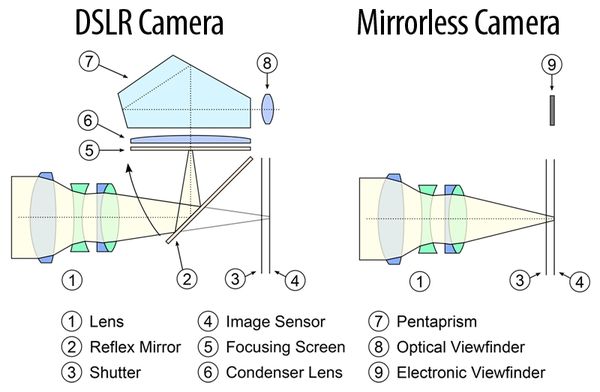DSLR v Mirrorless
Jan 15, 2019 10:34:27 #
I found a very nice graphic comparing the guts of the DSLR to the Mirrorless MILC.
Jan 15, 2019 10:57:32 #
CatMarley wrote:
I found a very nice graphic comparing the guts of the DSLR to the Mirrorless MILC.
Nice graphic Cat and easily shows the difference in the two systems. As for me jumping in the mirrorless bandwagon, that's not going to happen. At 72 years old and upgrading last year to the Canon 5D Mk IV and 80D which take stellar images if I do my part, I see no need to change systems.
Jan 15, 2019 11:08:34 #
From this graphic, it looks like the MILC is a simpler design, with less stuff to break and fail compared to a DSLR. Of course this graphic is only displaying the optical path.
Jan 15, 2019 11:10:10 #
CatMarley wrote:
I found a very nice graphic comparing the guts of the DSLR to the Mirrorless MILC.
So with so much simplicity in the mirrorless why is it not half the price retail?
I would believe manufacturing is much less and can be more automated.
Jan 15, 2019 11:14:04 #
Architect1776 wrote:
So with so much simplicity in the mirrorless why is it not half the price retail?
I would believe manufacturing is much less and can be more automated.
I would believe manufacturing is much less and can be more automated.
I can agree with that being said!
Jan 15, 2019 11:27:07 #
CatMarley wrote:
I found a very nice graphic comparing the guts of the DSLR to the Mirrorless MILC.
Great illustration. Similar diagrams have been around, but this one's cleaner than most. It really shows how complex the dSLR/SLR design is, compared to mirrorless (or, going back decades, rangefinder) designs.
The story of dSLR and mirrorless is more complicated than the word, 'versus'. I do think that mirrorless schemes will eventually replace reflex viewing schemes. However, at the current time, both systems have distinct advantages and disadvantages. As microprocessors and sensors and OLED displays and EVFs become more capable (quicker), there will be faster adoption of mirrorless gear.
Canon and Nikon getting into the mirrorless full frame fray will (longer term) be great for the industry. But don't rule out Fujifilm, Olympus, Panasonic, and Sony. Each has a unique feature set to offer.
It's basic human tendency to want to pick a "best" of everything. However, "best" is nearly always relative to the task at hand. It behooves each of us to do our homework to be reasonably sure we get the right system(s) for our needs. I gave up Canons and Nikons a few years ago for a specific feature set I needed — a balance of stills and video capabilities in a small package. It was the right choice for me. But I agonized over it for two years before I made the jump. It was worth the time to research my options!
Jan 15, 2019 11:43:21 #
Architect1776 wrote:
So with so much simplicity in the mirrorless why is it not half the price retail?
I would believe manufacturing is much less and can be more automated.
I would believe manufacturing is much less and can be more automated.
In economics 101, there is this graph of price vs quantity vs marginal cost vs marginal revenue vs maximum revenue. It's still burned into my brain from my days as an econ major.
When manufacturing anything in quantity, there is always a LOT of cost upfront for research, design, engineering, marketing and advertising...
That means the cost of the first unit is astronomical. Make two, and the cost of each unit is cut in half. Make 100, and it's down to 1%. But it's still astronomical. Make (and sell) 100,000, and it is very reasonable!
Manufacturers typically price new goods or services high, for several reasons. First, they want to recoup as much of their startup investment as possible. Second, if the product is any good, they want to take advantage of "new, exciting, innovative, cool," and similar demand drivers. Demand for a product falls over time, as there are fewer likely buyers, competition sets in, and even newer devices become available.
A camera manufacturer might release a body at launch for $1999. But two years later, it is likely to be priced 20% less ($1599). That is the sort of case with several cameras I've followed over the past few years. The company has recouped most of its tooling costs, demand falls, and the price falls to boost demand and take advantage of reduced costs of production due to efficiency. If it is EXTREMELY popular, the price stays the same, because the demand supports it. Apple, for instance, enjoyed a ten year ride with iPhones being priced the same at the beginning of their product cycles, all the way to the introduction of each successive model. Only the new model would knock down the price of the old one. As the market matures, that is changing...
Mirrorless is new, in demand, exciting, etc. Once the dSLR market fades a bit, prices of mirrorless will fall slowly (adjusted for inflation and currency floats).
Jan 15, 2019 11:43:38 #
Im not going to buy a mirrorless camera either. Getting ready to buy a Canon 1dx2. If I did buy a mirrorless it would be to add to what I have, not replace it. I don't understand why people think that buying a mirrorless camera means they have to get rid of their current equipment.
Jan 15, 2019 11:50:05 #
Strodav
Loc: Houston, Tx
From my engineering standpoint, the mirrorless camera is a much simpler device as Cat's diagram shows, less parts, no moving parts, and should be much easier to build, align and calibrate. Why is Nikon charging $350 more (with adapter) for the Z7 as compared to the D850? I will wait for a year, maybe two, and let the market settle out before adding a mirrorless body to my dslrs. There is going to be a lot of downward price pressure with competition. I also want to make sure it it is truly an upgrade, not a lateral move.
Jan 15, 2019 11:54:09 #
Vietnam Vet wrote:
Im not going to buy a mirrorless camera either. Getting ready to buy a Canon 1dx2. If I did buy a mirrorless it would be to add to what I have, not replace it. I don't understand why people think that buying a mirrorless camera means they have to get rid of their current equipment.
In many cases, older lenses can complement newer mirrorless purchases. Both Canon and Nikon have adapters to mount their dSLR lenses onto mirrorless bodies, with full functions.
In some cases, dSLR designs just don't meet one's needs. In my case, I used SLRs and dSLRs from both Canon and Nikon for years. But I needed a better hybrid digital solution to record roughly equal amounts of both stills and video. I found that in a Panasonic GH4 a few years ago. It was a radical switch to move from full frame and APS-C to Micro 4/3, but it was totally worth it.
Jan 15, 2019 12:07:49 #
CatMarley wrote:
I found a very nice graphic comparing the guts of the DSLR to the Mirrorless MILC.
It is even worse than this. DSLRs have a separate focus sensor not shown here.
Jan 15, 2019 12:35:49 #
burkphoto wrote:
In economics 101, there is this graph of price vs ... (show quote)
I had the same econ classes.
It's just that I see no real downward trend look at those who have been at it for years in mirrorless.
Sony regurgitates slight improvements but still no drop in price.
Yes once there is competition especially from Nikon seeing they use the same sensors there might be a drop.
But mechanically the simplicity still begs the question.
Jan 15, 2019 13:07:17 #
rook2c4 wrote:
From this graphic, it looks like the MILC is a simpler design, with less stuff to break and fail compared to a DSLR. Of course this graphic is only displaying the optical path.
The light path to the sensor and the viewer, through the aperture and the shutter. Which is just about everything in the camera except the shutter mechanism, the box and the electronics. What it does point out is the complications that the MILC eliminates. and of course the intimation that the simplification results in an easier machine to construct, due to the fewer mechanical parts.
Jan 15, 2019 13:17:52 #
Vietnam Vet wrote:
Im not going to buy a mirrorless camera either. Getting ready to buy a Canon 1dx2. If I did buy a mirrorless it would be to add to what I have, not replace it. I don't understand why people think that buying a mirrorless camera means they have to get rid of their current equipment.
They don't buy an MILC INTENDING to get rid of their DSLR. In the beginning they say, "Now I can take advantage of the best of both!" After a couple of months they find a lot of dust gathering on the DSLR, and after another half a year, they either sell it or give it to a relative.
Jan 15, 2019 13:21:28 #
Strodav
Loc: Houston, Tx
Architect1776 wrote:
I had the same econ classes.
It's just that I see no real downward trend look at those who have been at it for years in mirrorless.
Sony regurgitates slight improvements but still no drop in price.
Yes once there is competition especially from Nikon seeing they use the same sensors there might be a drop.
But mechanically the simplicity still begs the question.
It's just that I see no real downward trend look at those who have been at it for years in mirrorless.
Sony regurgitates slight improvements but still no drop in price.
Yes once there is competition especially from Nikon seeing they use the same sensors there might be a drop.
But mechanically the simplicity still begs the question.
My local camera shop here in Houston held a major vendor day event a few months back [the day I bought a D850]. Nikon was there and as an EE, I asked several questions about Nikon sensors from several different angles, especially sensors for the D7200, D500, D750 and D850. I was assured Nikon has its own sensor R&D group, they design all their own sensors, but contract out to various CMOS foundries for parts built to Nikon specs and quality standards. Was I lied to?
If you want to reply, then register here. Registration is free and your account is created instantly, so you can post right away.







